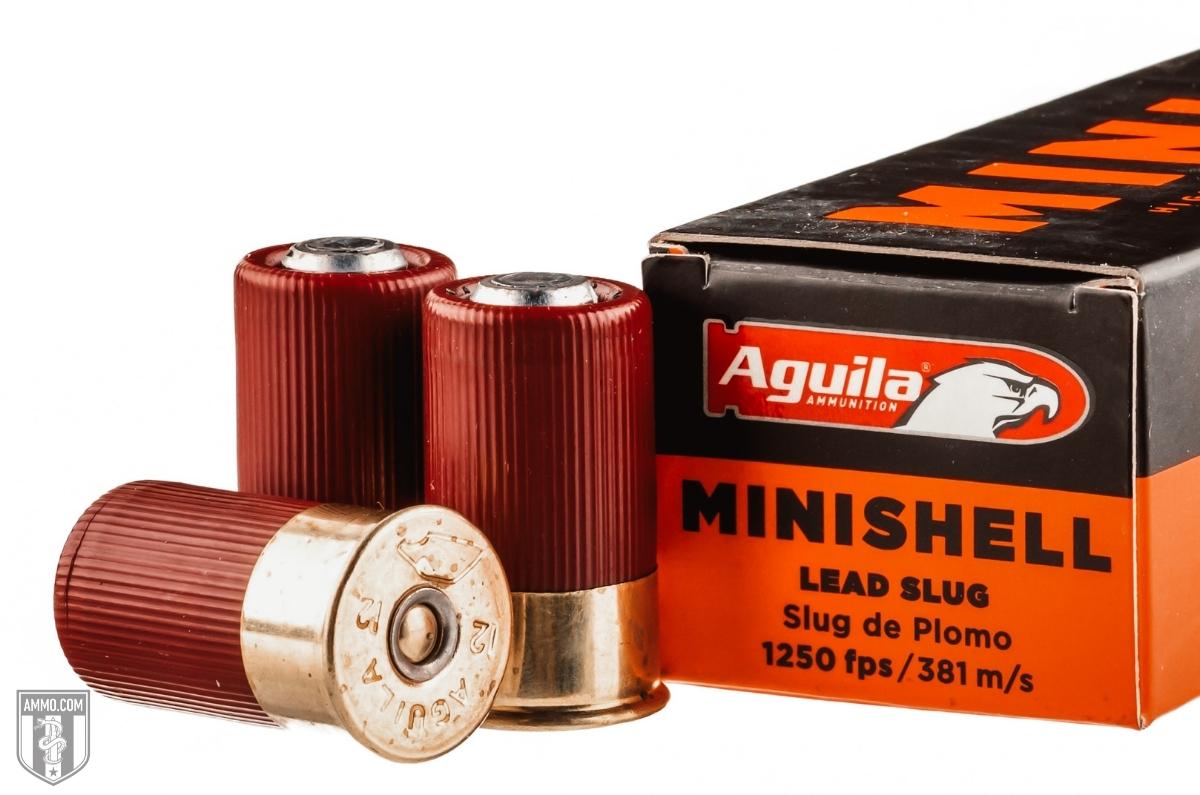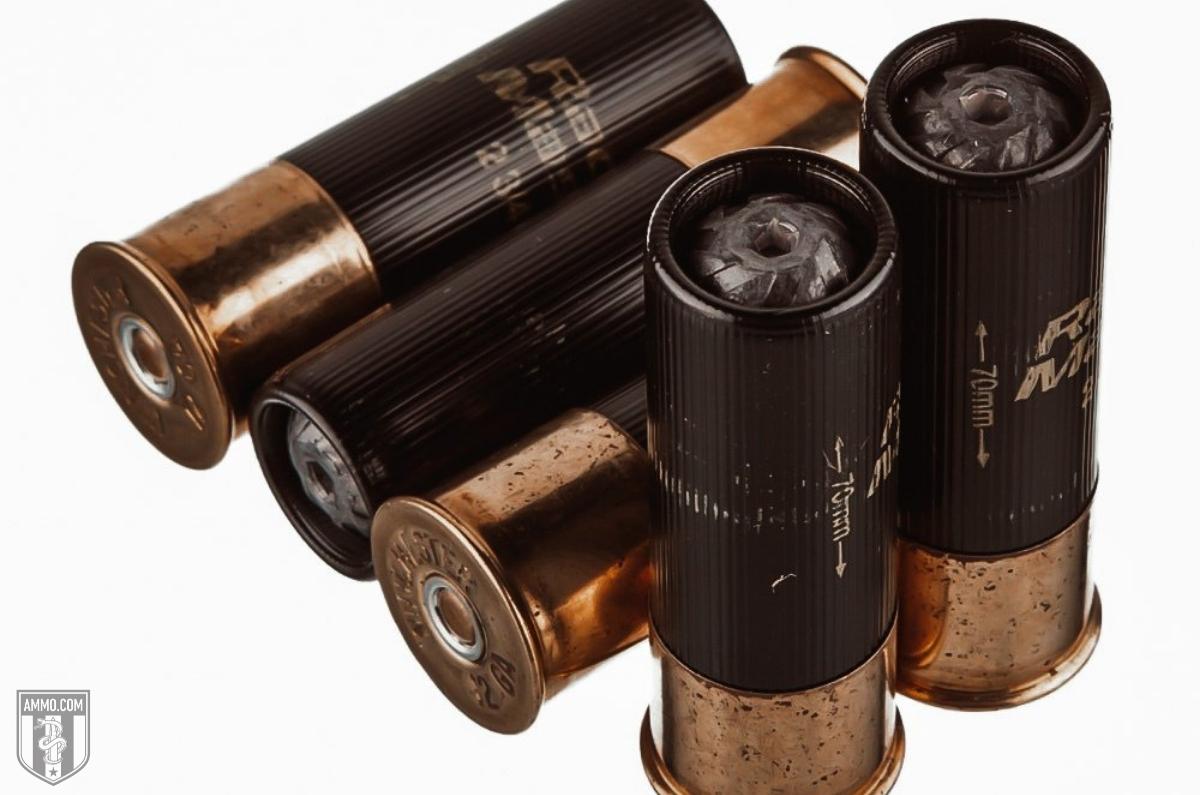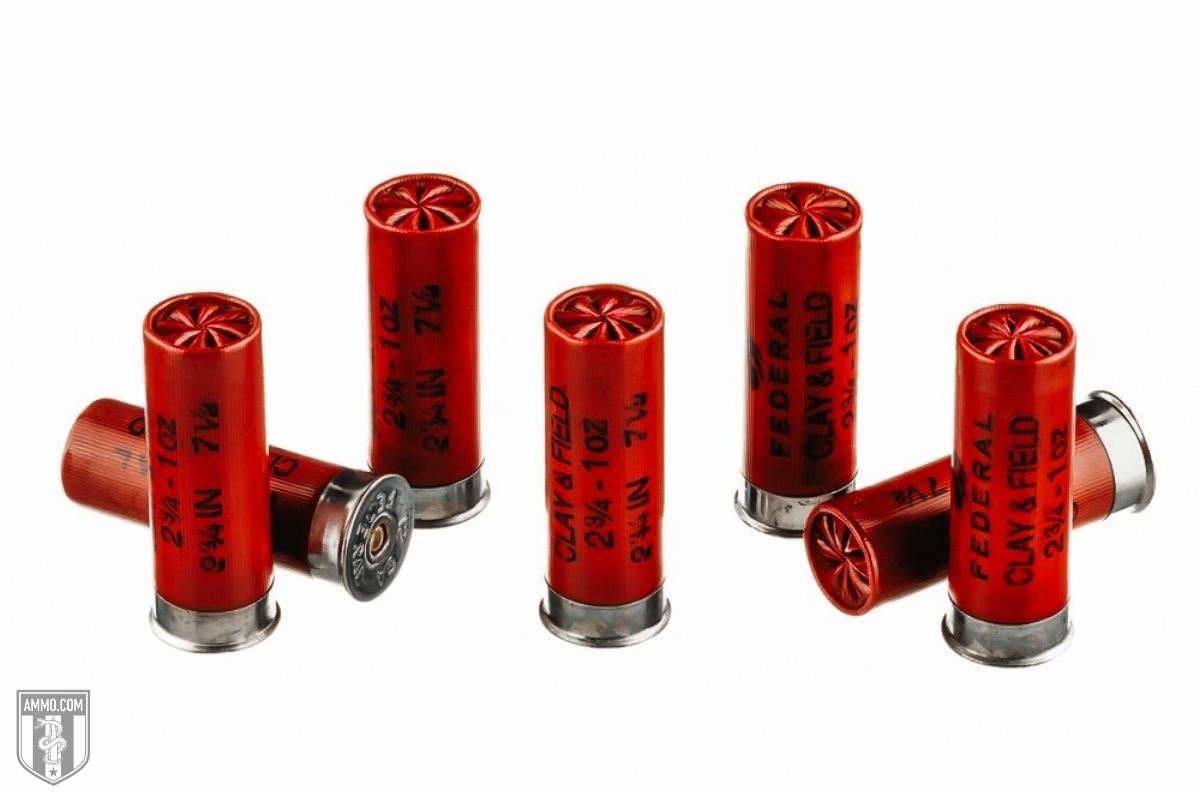10 Gauge vs 12 Gauge: The Shotgun Shootout Part II
 Shotguns are the most versatile gun you can purchase. They come in various styles, barrel lengths, ammo options, and gauges. Choosing a shotgun gets confusing to new gun enthusiasts with so many options.
Shotguns are the most versatile gun you can purchase. They come in various styles, barrel lengths, ammo options, and gauges. Choosing a shotgun gets confusing to new gun enthusiasts with so many options.
We're here to help make that decision easier when purchasing a 10 gauge vs 12 gauge. The 12 gauge shotgun is the most popular in the US. In contrast, the 10 gauge shotgun is popular within a small niche of hunters. Ultimately, the decision boils down to your plan to use it and your price range.
Let's transition to the similarities and significant differences between these two gauges.
Is There Much Of A Difference? 10 Gauge vs 12 Gauge Shotguns
When choosing which gauge to purchase, you must understand what gauge means to make the best decision. When talking about the gauge of a shotgun, we speak of the bore diameter, similar to rifles and handguns, but gauges are measured backward.
For instance, as the number of the caliber increases, the size of the bullet increases in rifles and handguns, so a .243 is smaller than a .308 and a .40 is smaller than a .45.
In shotgun gauges, the opposite is true. As the number gets larger, the size of the bore gets smaller. So a 10 gauge has a bigger bore than a 12 gauge. It's confusing at first, but you'll quickly get the hang of it as you spend more time studying shotguns.
We will discuss why this is in the shotgun shell development and history section.
In all honesty, there's not a massive difference between a 10ga and a 12ga. I think this is why the 12-gauge is so much more popular than the 10-gauge.
Shell Specs
Learning shotgun gauges is more confusing than learning other guns and calibers because of the wide variety of shotgun shells available per gauge. Each gauge has different shell lengths, shot sizes, and shot types.
So though a shell might have the same specs as another, they will shoot differently. The bore diameter for a 10ga shotgun is 0.775". It's rare to find a length for 10 gauge shells chambered in anything other than 3 1/2," but they do exist in 3". A light waterfowl 10ga load is 1 3/8oz. In contrast, some turkey loads are as much as two ounces.
The bore diameter for a 12ga shotgun is only slightly smaller at .729". However, 12 gauge shells are chambered for 2 3/4", 3", and 3 1/2". A light waterfowl load for a 12ga is 1 1/16oz, and a 12ga turkey load will also reach two ounces.
If you quickly glance at a 3 1/2" 10 gauge shell and a 3 1/2" 12 gauge shell, it might be challenging to see the difference because, unlike with 20ga shells, 10ga and 12ga shells can be the same color.
However, upon further inspection, the 10ga is slightly larger in diameter, so it will not fit into a 12ga gun. You can, however, accidentally stick a 12 gauge shell into a 10 gauge gun, which could cause serious injury to the shooter and the gun.
So be careful not to mix shells if you're shooting a 10ga and 12ga simultaneously. Always use the correct ammo for the gun you're using.
Recoil
Contrary to popular opinion, the recoil of a 12ga vs 10ga shotgun is very similar, especially when you're shooting a 3 1/2" 12 gauge shell. Some would even argue a 10-gauge has less recoil than a 12-gauge. The primary reason for this is the weight of the 10 gauge shotgun.
Most 12ga shotguns weigh between six and eight pounds which makes repeatedly shooting a 3 1/2" turkey load rather uncomfortable due to the excessive recoil from combining a lightweight firearm and a heavy load.
On average, a 10ga shotgun weighs 10-11lbs. That's a heavy gun! This additional weight helps reduce the felt recoil even when shooting the larger shells with more powder.
It's wise to remember that all guns kick differently, even if they're the same gauge. Single shot, pump-action, and semi-auto shotguns all have different felt recoil because of how they use or don't use the recoil to cycle the shotshell.
The same is true for the various shell lengths. A 2 3/4" shell will have less recoil than a 3" which won't have the amount of kick a 3 1/2" shotshell has; this is because of the amount of powder each shell is capable of holding.
If you decide which gauge to purchase from recoil alone, I would still go with the 12 gauge and use 3" or smaller shells.
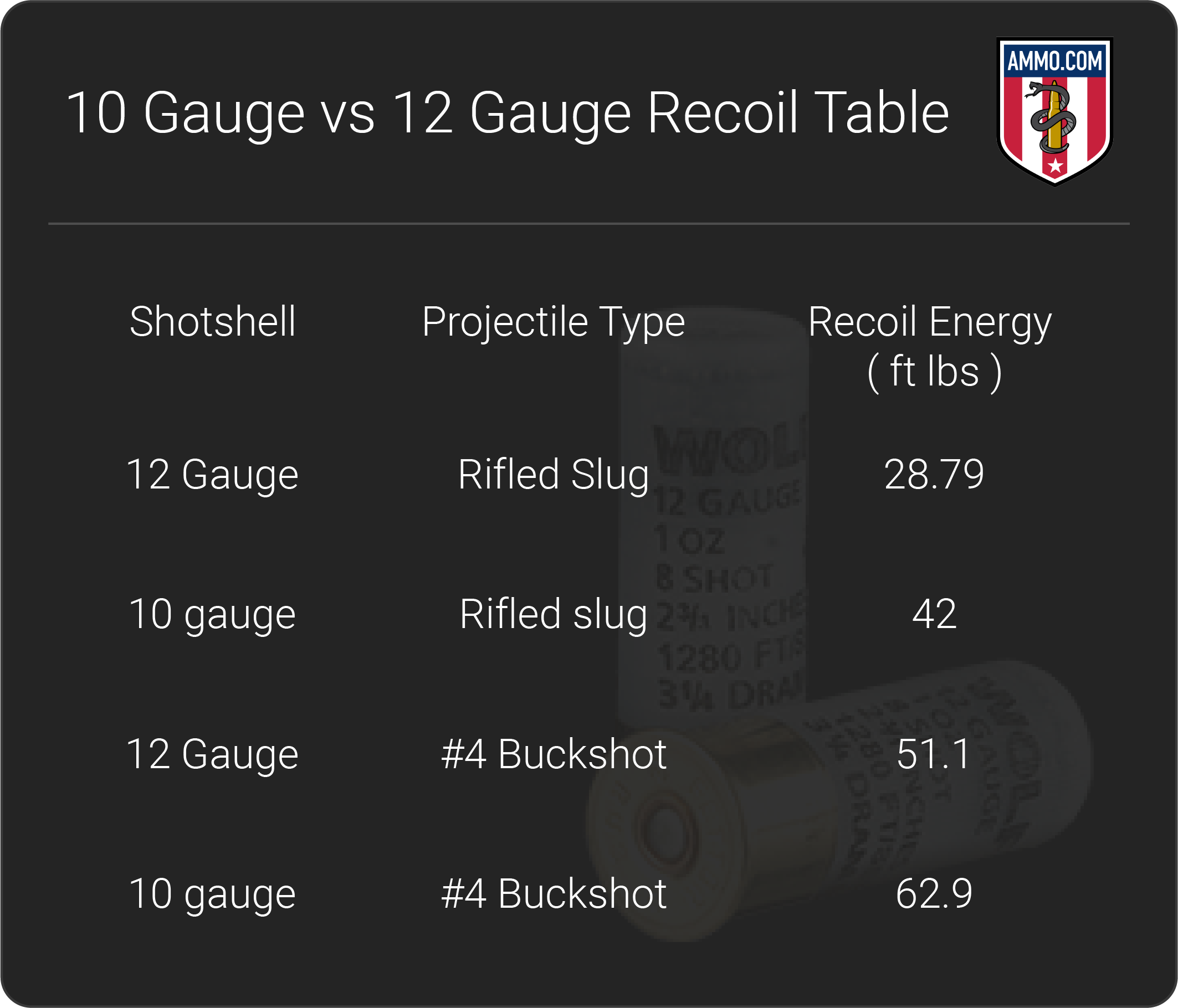
Lethal Range
Shotguns are not designed for long-range shooting. For small game, most shotguns are lethal out to 40 yards. Even though a 10 gauge can shoot further than 60 yards, I recommend 60 yards as a maximum distance.
Though I've witnessed 12-gauges drop ducks out to 60+ yards, I recommend a maximum distance of 50 yards, and even that is a long shot for a 12ga. I prefer my targets within 30 yards when shooting my 12-gauge.
Several variables factor into the lethal range of a shotgun, and none is more significant than shell selection. If you choose a smaller shot size, it won't have enough energy to go as far as a more prominent shot size.
When shooting a slug, it's a little different because the slug is more similar in shape to a bullet than a pellet or BB. For the average person shooting a 12 gauge rifled slug, the maximum effective range is 100 yards or fewer. However, a 12ga slug in the hands of a skilled marksman can be lethal out to 300 yards.
Rifled slugs are needed in shotguns because the shotgun barrel is smooth inside, unlike a rifle barrel with grooves that cause the bullet to spin. Sabot slugs don't have rifling, so they're not as accurate at longer ranges. Generally speaking, 10 gauge slugs have a similar range to 12ga slugs.
A 10 gauge shotgun has a farther lethal range than a 12 gauge, but only slightly.
Accuracy
Shotguns were invented to help minimize the need for accuracy when hunting fowl and other small game. I'm not saying that shotguns can't be accurate, but I'm also not saying they shouldn't be accurate.
However, the accuracy of a shotgun is not determined in the same manner as a rifle. Let me explain. A rifle has only one projectile, whereas a shotgun (besides when using a slug) has multiple projectiles.
So the accuracy of a rifle round is based on that single projectile, and the accuracy of a shotgun is based on how many pellets you can put on the target.
Shotguns are rarely fired from a resting position, maybe while turkey hunting, but even then, there are times when you're fully supporting the firearm. However, for the sake of argument, we will discuss how accurate a 12ga vs. 10ga is by determining which will put more pellets on target at 40 yards using similar shotshells.
A 10 gauge with a larger bore will put land more BBs on target than a 12 gauge at 40 yards when shooting comparable rounds to cut to the chase. Once again, there's a disclaimer because each shell is unique, and each gun patterns shells differently.
So for shooting farther distances, the 10 gauge is more accurate. That's one reason hunters use it for turkey and goose hunting. However, they are so similar in close ranges that it's difficult to tell the difference.
Stopping Power
To a point, the shotgun gauge doesn't determine the stopping power. A 10ga and 12ga are similar enough that stopping power is primarily determined by the payload and projectiles of the shotshells you choose to shoot.
However, if you compare a 20-gauge to a .410, you will see a more significant difference in stopping power because there is a larger separation in size between each gauge.
000 buckshot used for deer hunting has more stopping power than #9 birdshot used for quail and pheasant hunting because the 000 buckshot projectiles have more mass than #9 birdshot.
A slug has the most stopping power of any shotshell projectile because it has the most mass. Another way stopping power is increased by increasing the amount of powder. This isn't ideal because it causes more recoil and, if done improperly, can cause the gun to explode because it's not capable of handling the pressure created by the extra powder.
So if you have a buddy who's into reloading, check the specs on his shells and your gun before firing them!
It should be mentioned that when compared using the closest equivalent shotshell, a 10 gauge has slightly more stopping power than a 12 gauge at longer ranges due to the larger payload of the shell because of the larger 10ga shotgun bore.
Hunting
In general, shotguns are used for small game and medium game. Big game can be hunted with a shotgun; however, you'll need to get as close to your target as you would with a bow and use slugs. So it's best to stick with a large rifle when big game hunting. Upland birds, waterfowl, and deer are the most common animals hunted with shotguns.
The 10 gauge goose gun, as it's sometimes called, is the choice of a select few goose hunters. This was especially true prior to 12-gauge steel shot ammo being manufactured in 3 1/2 inch shells. The extra knockdown power of the 10 gauge was needed for a clean shot on large Canada geese while waterfowl hunting.
Once modern shotshells with steel shot were invented, 12-gauge guns began to overtake 10-gauge guns in popularity amongst waterfowl hunters. There are still a few that hunt with a 10-gauge out of tradition. The Browning Gold 10ga and Remington SP-10 are two of the most popular 10-gauge shotgun models.
The 12ga is more prevalent amongst upland hunters because of the availability of small shot sizes, 2 3/4 inch 12-gauge shells, and it isn't as heavy as a 10-gauge. So carrying a 12ga while walking all day isn't as strenuous. Skeet shooters also prefer the 12ga.
12-gauges are also more popular amongst deer hunters because the shotshells are more abundant. 10ga shells are difficult to find, especially in buckshot or slug, needed for deer hunting. The Remington 870 and Mossberg 500 were two of the most popular models for 12ga hunters for decades. In recent years, Benelli and Winchester have overtaken them.
Don't forget to check our stock of Remington 12 Gauge Ammunition as well as our Winchester 12 Gauge ammo page to compare your options.
If you're purchasing a shotgun for hunting purposes, a 12ga is the way to go. You can hunt a wider variety of animals with it, and the ammo is more readily available.

Home Defense
You can't get a better home defense gun than a shotgun, and it's not because the sound of loading a round in the chamber scares off intruders.
A shotgun is the best home defense weapon because you don't have to be as accurate with it, it's capable of holding multiple rounds, and if you're using the correct shotshells, the projectiles won't penetrate walls. This means you, your family, and your neighbors will be safer from friendly fire.
In the close quarters of your home, a 10ga is overkill for protection. It's heavy, so it won't be as easy to maneuver in tight spaces and you don't need the extra range in close quarters.
A 12ga is a better option than a 10ga because of the availability and variety of ammo. It's also not as heavy, so handling it is much easier. However, I would argue a 20-gauge shotgun is just as good as a home defense gun. For more on the 20ga, don't miss our 12 gauge vs 20 gauge article.
With that said, the 12ga Mossberg 500 is one of the most popular shotguns amongst law enforcement agencies. So if the police and military believe a 12-gauge to be the best in a gun battle, who am I to argue?
If you need to purchase a home defense gun, get a 12ga with 0 buckshot shotshells rather than a 10ga.
Ammo and Shotgun Cost and Availability
Firearms and ammo have become increasingly scarce and more expensive in recent years, which is terrible news for those of us who enjoy shooting. I've already hinted at which shotgun gauge is slowly headed towards obscurity, and that's the 10ga.
10-gauge shotguns and shotshells were difficult to find before the ammo and gun shortages because the gauge is popular amongst such a small population of firearms enthusiasts. Some of the most popular 10ga shotguns, like the Remington SP-10, have been discontinued due to low demand.
With the help of the internet, it is easier to find 10-gauge guns and ammo, but they're not as prevalent as 12-gauge ammo and shotguns. At the peak of the ammo shortage, I found it challenging to find waterfowl hunting loads with bismuth, steel shot, or tungsten, but there were usually a few boxes of 12-gauge loads of lead shot for clays and upland game hunting.
The 12-gauge is the most popular shotgun, so guns and ammo are usually easier to find and less expensive than the 10-gauge. Honestly, it's not what I would consider cheap, either. The most affordable 12 gauge rounds will still cost you about $0.50 per round, while some of the most expensive 12ga ammo will cost over $2 per round!
A 10ga slug, one of the more expensive rounds, will cost over $3.50 per trigger pull. Since 10-gauge shotshells are rarer, the "cheap" shells will cost over $1.50 per shell.
It's best to keep in mind the shell length and shot type are primary drivers of prices. So a 12-gauge 2 3/4 inch #9 shot will be less expensive than a 12ga 3 1/2 inch 00 buckshot. The metal used for pellets is another factor that determines the price. Lead is cheaper than steel, tungsten, and bismuth.
So if you're on a tight budget, it should be pretty apparent that 12-gauge guns and ammo are much less expensive in the long run than 10-gauge ammo and firearms.
Buying in bulk is always smart, make sure to check out our stock of bulk 12 gauge ammo.
Reloading
Shotshell reloading isn't as popular as rifle and handgun reloading. This is because the store-bought ammo is effective enough to get the job done. However, there are a select few that enjoy reloading unique shotgun ammo.
Reloading shotshells requires a different press and set up than a rifle and handgun, which is another reason most shooters don't bother reloading. The plastic hulls are relatively inexpensive, so most of the cost is from powder and projectiles. However, it's not cost-effective to reload shotgun shells unless you're a competitive shooter who shoots every day.
Some turkey and goose hunters prefer to reload their 10-gauge because ammo is more challenging to find. They can also load the shells to get a better pattern and more range out of their gun.
For 12-gauge owners, it's easier and no more expensive to purchase several different brands to see which one patterns best and has the farthest range instead of taking time to reload.
Some people find reloading enjoyable and relaxing, so if that's you, then I say go for it! Just don't lie to yourself and say you're doing it to save money because it's unlikely you're saving much when you factor in the cost of your time on top of all the equipment you need.
Ballistics
The ballistics of each gauge are surprisingly similar when comparing equal rounds (3 1/2" 10ga vs. 3 1/2" 12ga). This is because of the advancement of smokeless powder and shotshell manufacturing.
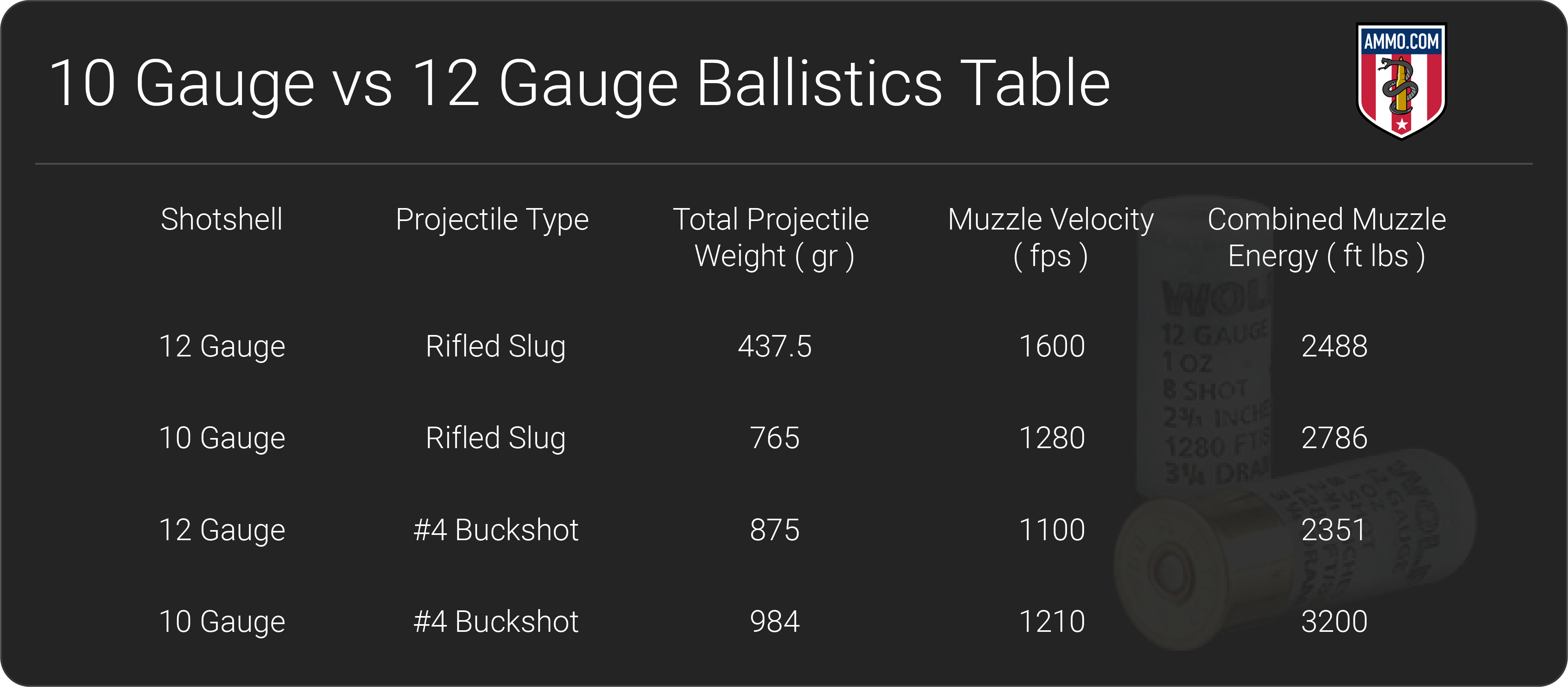
Shotgun Shell Development and History
A shotgun gauge is determined by the number of lead balls equal in diameter to the barrel's bore size it takes to equal a pound. So it takes ten lead balls with a diameter of 0.775 to equal a pound. Therefore we call it a 10ga, and it takes 12 lead balls with a diameter of 0.729 to equal a pound, so we call it a 12 gauge.
The method for determining the shotgun gauge was developed several hundred years ago, so it's outdated. However, we still use the term "gauge" when talking about shotgun "calibers" or bore diameter.
The term "shotgun" was coined in the late 1770s, and the gun became extremely popular during the civil war and in The West shortly after the war. Shotshells were first made of all brass but then transitioned to paper hulls with brass bases in the mid-1800s. Paper hulls reigned supreme for nearly one hundred years until plastic hulls overtook them in the 1960s.
Final Shots: 12 Gauge vs 10 Gauge
I know I'm biased because I grew up shooting 12-gauge shotguns, and I now own multiple 12-gauge shotguns. So maybe I'm not very unique, but it's the most popular shotgun on the planet for a reason.
A 12ga is versatile, ammo is relatively inexpensive and easy to find, and they're lighter guns. That does mean that when a 10 gauge vs 12 gauge is directly compared, the 12ga has slightly more recoil.
Even though it's heavy, the 10ga has a unique draw for waterfowl and turkey hunters. It's steeped in tradition, and honestly, it's a tradition I hope continues. That being said, it's difficult to become a part of because it's been overshadowed by the 12ga.
Ammo Comparisons
- .308 vs 5.56
- 6.5 Creedmoor vs .308
- .300 Blackout vs .308
- .300 Win Mag vs .308
- .243 vs .308
- .308 vs .30-06
- 7mm-08 vs .308
- .270 vs .308
- 7.62x39 vs .308
- .223 vs .308
- .338 Lapua vs .308
- .380 ACP vs 9mm
- .223 vs 5.56
- .300 Blackout vs 5.56
- 9mm vs 45 ACP
- 9mm vs 40 S&W
- .357 SIG vs 9mm
- 10mm vs 9mm
- 9mm vs 9mm Luger
- .243 vs .270
- .300 Win Mag vs .30-06
- .270 vs .30-06
- .40 vs .45
- 38 Special vs 357
- 9mm vs 40 vs 45
- 5.56 vs 7.62x39
- 338 Lapua vs .30-06
- .30-30 vs .30-06
- 300 PRC vs 338 Lapua
- .30-06 vs 7mm
- 300 Win Mag vs 338 Lapua
- 300 PRC vs 300 Win Mag
- 300 WSM vs 300 Win Mag
- 338 Win Mag vs 338 Lapua
- 12 Gauge vs 20 Gauge
- 10mm vs 357 Mag
- .30-30 vs 7.62x39
- 224 Valkyrie vs 22-250
- 17 HMR vs 22 Mag
- 7.62x39 vs .300 Blackout
- 45 ACP vs 45 Auto
- 45-70 vs 30-30
- 300 Blackout vs 223
- 357 Magnum vs 9mm
- 350 Legend vs 300 Blackout
- 224 Valkyrie vs 223
- 45 ACP vs 38 Super
- 6.5 Grendel vs .308
- 17 HMR vs 22 LR
- 10 Gauge vs 12 Gauge
- 22-250 vs 223
- 45 Colt vs 45 ACP
- 350 Legend vs 30-30
- 5.7x28 vs 223
- 5.7 vs 9mm
- 5.56 vs 5.7
- 22 vs 9mm
- Buckshot vs Birdshot
- 450 Bushmaster vs 308
- 450 Bushmaster vs 223
- Buckshot vs Slug
- 6.5 Grendel vs 5.56 vs 223
- 6mm ARC vs 6.5 Grendel
- 44 vs 45
- 458 SOCOM vs 5.56
- 357 vs 44
- 32 ACP vs 380
- 300 Win Mag vs 338 Win Mag vs 338 Lapua Mag
- 450 Bushmaster vs 458 SOCOM vs 50 Beowulf
- 6mm Creedmoor vs 6.5 Creedmoor
- TMJ vs FMJ
- 44 Special Vs 44 Magnum
- 45 90 vs 45 70
- 6.8 Western vs 6.8 SPC
- 50 Beowulf vs 50 BMG
- 26 Nosler vs 6.5 PRC
- 28 Gauge vs 410
- 6.8 SPC vs 5.56
- 6.8 SPC vs 6.5 Grendel
- 6.8 Western vs 7mm Rem Mag vs .28 Nosler
- 6.8 Western vs 6.5 Creedmoor
- 22 Hornet vs 223
- 6.8 Western vs 6.5 PRC
- .410 vs 12 Gauge
- .410 vs 20 Gauge
- 22 LR vs 22 Mag
- 6mm ARC vs 243
- 7mm-08 vs 270
- 243 vs 6.5 Creedmoor
- Nickel vs Brass Casing
- 204 Ruger vs 223
- 50 Beowulf vs 5.56
- 260 Remington vs 6.5 Creedmoor
- 6mm Remington vs 243
- 28 Nosler vs 300 PRC
- 50 Beowulf vs 50 AE
- 22 Nosler vs 22-250
- 450 Marlin vs 45-70
- 300 Win Mag vs 300 Norma
- 458 SOCOM vs 300 Blackout
- 38-55 vs 45-70
- 22 Hornet vs 22 LR
- 300 Norma vs 338 Lapua
- 338 Lapua vs 50 BMG
- 28 Nosler vs 300 Win Mag
- 28 Nosler vs 6.5 Creedmoor
- 204 vs 22-250
- 458 SOCOM vs 45 70
- 44 40 vs 45 70
- 6.8 SPC vs 6.5 Creedmoor
- 450 Bushmaster vs 30-06
- 7mm Rem Mag vs 300 Win Mag
- 30 Carbine vs 223
- 25-06 vs 30-06
- 26 Nosler vs 28 Nosler
- 16ga vs 12ga
- 30 06 vs 7.62 x54R
- 9mm Makarov vs 9mm Luger
- 350 Legend vs 223
- 30 Carbine vs 5.56
- 6.5x55 vs 6.5 Creedmoor
- 6.5 Creedmoor vs 270 vs 25-06
- M193 vs M855
- 450 Bushmaster vs 458 SOCOM
- 6.5 Grendel vs 6.5 Creedmoor
- 350 Legend vs 5.56
- .277 Fury vs 6.8 SPC
- 277 Fury vs 300 Win Mag
- 10mm vs .45 ACP
- 277 Fury vs 223
- 6.8 SPC vs 300 Blackout
- 6.5 PRC vs 6.5 Creedmoor
- 277 Fury vs 308
- 277 Fury vs 6.5 Creedmoor
- 350 Legend vs 450 Bushmaster
- 277 Fury Vs 5.56 NATO
- 10mm vs 40S&W
- 32 ACP vs 9mm
- 32 Special vs 9mm
- 8.6 Blackout vs 300 Blackout
- 30 Super Carry vs. 9mm
- 5.56 vs 9mm
- .50 Action Express vs 9mm
- 7.62x25 vs. 9mm
- 10mm vs 44 Magnum
- 300 Blackout vs 300 Win Mag
- 6.5 Grendel vs 300 Blackout
- 460 Rowland vs 10mm
- 300 RUM vs 300 PRC
- 300 Norma vs 300 PRC
- 45 GAP vs 45 ACP
- 7mm PRC vs 300 Win Mag
- 300 PRC vs 6.5 Creedmoor
- 300 PRC vs 308
- 357 SIG vs 357 Mag
- 7.62x39 vs 7.62x51
- 243 Win vs 223 Rem
- 30 Nosler vs 300 PRC
- 6.5 Creedmoor vs. 30-06 Springfield
- 450 S&W vs. 44 Magnum
- 6.5 Creedmoor vs. 300 Win Mag
- 454 Cassull vs. 45-70 Govt
- 454 Cassull vs. 44 Mag
- 7.62x54r vs. 308 Winchester
- 22 ARC vs. 223 Rem
- Subsonic vs. Supersonic Ammo
